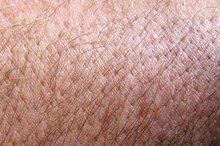What does fact checked mean?
At Healthfully, we strive to deliver objective content that is accurate and up-to-date. Our team periodically reviews articles in order to ensure content quality. The sources cited below consist of evidence from peer-reviewed journals, prominent medical organizations, academic associations, and government data.
- National Institute of Diabetes and Digestive and Kidney Disorders: Adrenal Insufficiency and Addison’s Disease
- National Institute of Arthritis and Musculoskeletal and Skin Diseases: Vitiligo
The information contained on this site is for informational purposes only, and should not be used as a substitute for the advice of a professional health care provider. Please check with the appropriate physician regarding health questions and concerns. Although we strive to deliver accurate and up-to-date information, no guarantee to that effect is made.
About Addison's Disease and Skin Pigment
In Addison’s disease, or primary adrenal insufficiency, the adrenal glands do not produce enough of the hormones cortisol and aldosterone. Low levels of these hormones produces symptoms like muscle weakness and fatigue, salt cravings, and low blood pressure and electrolyte imbalances that can be life-threatening. Addison’s disease also produces characteristic changes in skin color, or pigmentation.
Skin Darkening
With Addison’s disease, skin all over the body can gradually darken or bronze, a condition known as hyperpigmentation. Developing over a period of weeks, the hyperpigmentation can resemble a suntan. Areas of skin exposed to sun darken more, but unexposed areas also darken. Skin covering bony knobs like knees, elbows, knuckles, toes and forehead tends to darken more, as do skin folds and scars. The Merck Manual notes that black freckles often appear on the neck, shoulders and face, including the forehead.
- With Addison’s disease, skin all over the body can gradually darken or bronze, a condition known as hyperpigmentation.
- The Merck Manual notes that black freckles often appear on the neck, shoulders and face, including the forehead.
Discoloration
Diseases that Cause Eczema
Learn More
In addition to skin bronzing, Addison’s disease causes other changes in the distribution of skin pigment. The areola, or area around the nipples, the mucous membranes in the mouth including the lips, and the vagina and rectum take on a bluish-black hue. Other areas of the skin might take on a bleached appearance, so that patchy white areas contrast starkly with the hyperpigmented areas. Patchy loss of skin pigmentation is known as vitiligo 1.
- In addition to skin bronzing, Addison’s disease causes other changes in the distribution of skin pigment.
- The areola, or area around the nipples, the mucous membranes in the mouth including the lips, and the vagina and rectum take on a bluish-black hue.
Physiology
Normally, the pituitary gland of the brain and the adrenal glands coordinate their efforts to maintain proper levels of cortisol and aldosterone using a negative feedback loop. The pituitary hormone ACTH stimulates the adrenal glands to secrete its hormones; when adequate levels accumulate, they shut off the release of ACTH. In Addison’s disease, ACTH continuously bombards the adrenal glands in a fruitless attempt to stimulate adequate release of cortisol and aldosterone. ACTH also stimulates melanocytes, skin cells that produce melanin, the pigment that gives skin its color. Continuously high levels of ACTH in Addison’s disease over-stimulate the melanocytes, causing skin to darken all over the body.
The cause of vitiligo in Addison’s disease is not clear, but it might be due to changes in the body’s immune system that damage both the adrenal glands and the melanocytes.
- Normally, the pituitary gland of the brain and the adrenal glands coordinate their efforts to maintain proper levels of cortisol and aldosterone using a negative feedback loop.
- The pituitary hormone ACTH stimulates the adrenal glands to secrete its hormones; when adequate levels accumulate, they shut off the release of ACTH.
Treatment
Pathologic Dark Circles Around the Eyes
Learn More
Treatment for Addison’s disease involves replacing the missing adrenal hormones with medications. These medications help normalize ACTH levels as well, and over time, bronzed skin returns to its natural color. Destruction of melanocytes causing vitiligo is less easy to reverse, but treatments like cortisol creams or psoralen phototherapy to darken skin improve the skin’s appearance.
Insight
President John F. Kennedy suffered from Addison’s disease, a fact that was not made public during his presidency. Many people, including the media, wondered about his seeming year-round tan, which was likely hyperpigmentation resulting from his disease.
Related Articles
References
Writer Bio
In 20 years as a biologist, Susan T. McClure has contributed articles to scientific journals such as "Nature Genetics" and "American Journal of Physiology." She earned her Ph.D. from the University of Maryland. She enjoys educating people about science and the challenge of making complex information accessible.









